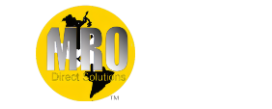When it comes to cleaning and maintenance operations, safety isn’t optional—it’s a legal requirement. The Occupational Safety and Health Administration (OSHA) sets strict standards to protect workers from potential hazards in the workplace. Failing to comply can result in costly fines, serious injuries, and reputational damage. At MRO Direct Solutions Inc., we help our clients not only maintain clean facilities but also support safer, OSHA-compliant operations.
Here’s what you need to know about OSHA compliance for cleaning and maintenance operations:
1. Hazard Communication Standard (HCS)
What It Means: Employers must inform workers about the hazardous chemicals they may encounter.
Key Requirements:
- Maintain updated Safety Data Sheets (SDS) for all cleaning chemicals.
- Properly label all chemical containers.
- Train employees on safe chemical handling and emergency procedures.
MRO Tip: Always purchase cleaning supplies from trusted vendors who provide proper SDS documentation.
2. Personal Protective Equipment (PPE)
What It Means: Employers must provide and ensure proper use of PPE to protect workers from chemical, biological, or physical hazards.
Key Requirements:
- Conduct a PPE assessment for each cleaning task.
- Provide appropriate gear (gloves, goggles, masks, aprons).
- Train employees on correct PPE usage and maintenance.
MRO Tip: Stock multiple sizes and replace damaged PPE immediately to stay compliant.
3. Bloodborne Pathogens Standard
What It Means: If workers are exposed to blood or other potentially infectious materials during cleaning, this standard applies.
Key Requirements:
- Develop an exposure control plan.
- Offer Hepatitis B vaccinations to at-risk employees.
- Train workers on safe cleaning methods and disposal procedures.
MRO Tip: Use color-coded cleaning tools and biohazard disposal systems to simplify compliance.
4. Walking-Working Surfaces Standard
What It Means: Facilities must maintain floors, stairways, and walkways to prevent slips, trips, and falls.
Key Requirements:
- Regularly inspect and maintain floors.
- Use “Wet Floor” signs during mopping or spill cleanup.
- Provide proper matting and slip-resistant surfaces where needed.
MRO Tip: Choose fast-drying floor cleaning solutions to reduce downtime and slip risk.
5. Respiratory Protection Standard
What It Means: If cleaning tasks involve hazardous airborne contaminants, employers must implement respiratory protection programs.
Key Requirements:
- Conduct air quality assessments if necessary.
- Provide certified respirators and fit testing.
- Train workers on proper respirator use and care.
MRO Tip: Use low-VOC and green-certified chemicals to minimize respiratory hazards whenever possible.
Why OSHA Compliance Matters
- Protects workers’ health and well-being
- Reduces accident-related downtime and costs
- Improves workplace morale and retention
- Shields your company from legal action and fines
- Enhances your brand reputation
At MRO Direct Solutions Inc., we help businesses source OSHA-compliant cleaning supplies, PPE, and equipment to create safer environments for everyone.
[Button: Explore OSHA-Compliant Solutions]
Final Thoughts
Safety is everyone’s responsibility, and understanding OSHA compliance is crucial for any organization that manages cleaning and maintenance operations. With the right supplies, training, and commitment, you can create a safer, healthier, and more productive workplace.
Need help selecting OSHA-compliant janitorial products and PPE?
Contact MRO Direct Solutions Inc. today — Delivering Peace of Mind with Every Order.
